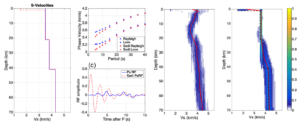Low-velocity layers within the crust can indicate the presence of melt and lithologic differences with implications for crustal composition and formation. Seismic wave conversions and reverberations across the base of the crust or intracrustal discontinuities, analysed using the receiver function method, can be used to constrain crustal layering. This is commonly accomplished by inverting receiver functions jointly with surface wave dispersion. Recently, the proliferation of model-space search approaches has made this technique a workhorse of crustal seismology. In a recent publication, we show that reverberations from shallow layers such as sedimentary basins produce spurious low-velocity zones when inverted for crustal structure with surface wave data of insufficiently high frequency. Therefore, reports of such layers in the literature based on inversions using receiver function data should be re-evaluated. We demonstrate that a simple resonance-removal filter can suppress these effects and yield reliable estimates of crustal structure, and advocate for its use in receiver-function based inversions.

synthetic SWD and Ps RF data. SWD data are generated for model without a sedimentary layer, while the Ps RF data are generated for the model with a
sedimentary layer (black dashed lines). The ensemble solutions are displayed as probability density functions at each depth, and the solid red line denoting the 5 per cent trimmed mean of the posterior. (far right) Same as right, except that the resonance removal filter has been applied to the Ps RF.
